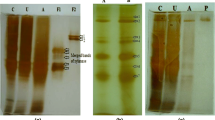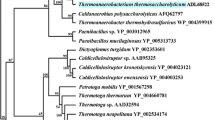Streptomyces sp. QG-11-3, which produces a cellulase-free thermostable xylanase (96 IU ml−1) and a pectinase (46 IU ml−1), was isolated on Horikoshi medium supplemented with 1% w/v wheat bran. Carbon sources that favored xylanase production were rice bran (82 IU ml−1) and birch-wood xylan (81 IU ml−1); pectinase production was also stimulated by pectin and cotton seed cake (34 IU ml−1 each). The partially purified xylanase and pectinase were optimally active at 60°C. Both enzymes were 100% stable at 50°C for more than 24 h. The half-lives of xylanase and pectinase at 70, 75 and 80°C were 90, 75 and 9 min, and 90, 53 and 7 min, respectively. The optimum pH values for xylanase and pectinase were 8.6 and 3.0, respectively, at 60°C. Xylanase and pectinase were stable over a broad pH range between 5.4 and 9.4 and 2.0 to 9.0, respectively, retaining more than 85% of their activity. Ca2+ stimulated the activity of both enzymes up to 7%, whereas Cd2+, Co2+, Cr3+, iodoacetic acid and iodoacetamide inhibited xylanase up to 35% and pectinase up to 63%; at 1 mM, Hg2+ inhibited both enzymes completely. Journal of Industrial Microbiology & Biotechnology (2000) 24, 396–402.
Similar content being viewed by others
Author information
Authors and Affiliations
Additional information
Received 29 September 1999/ Accepted in revised form 02 February 2000
Rights and permissions
About this article
Cite this article
Beg, Q., Bhushan, B., Kapoor, M. et al. Production and characterization of thermostable xylanase and pectinase from Streptomyces sp. QG-11-3. J Ind Microbiol Biotech 24, 396–402 (2000). https://doi.org/10.1038/sj.jim.7000010
Issue Date:
DOI: https://doi.org/10.1038/sj.jim.7000010




